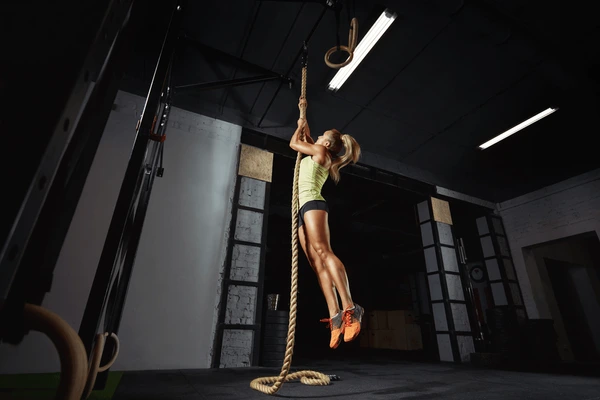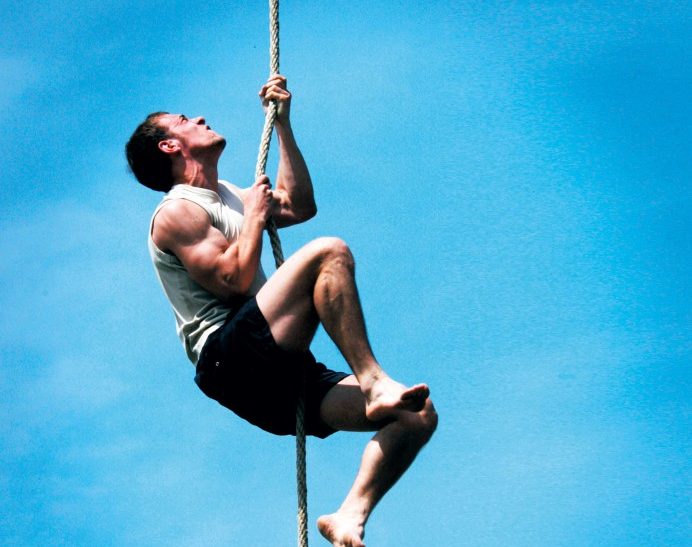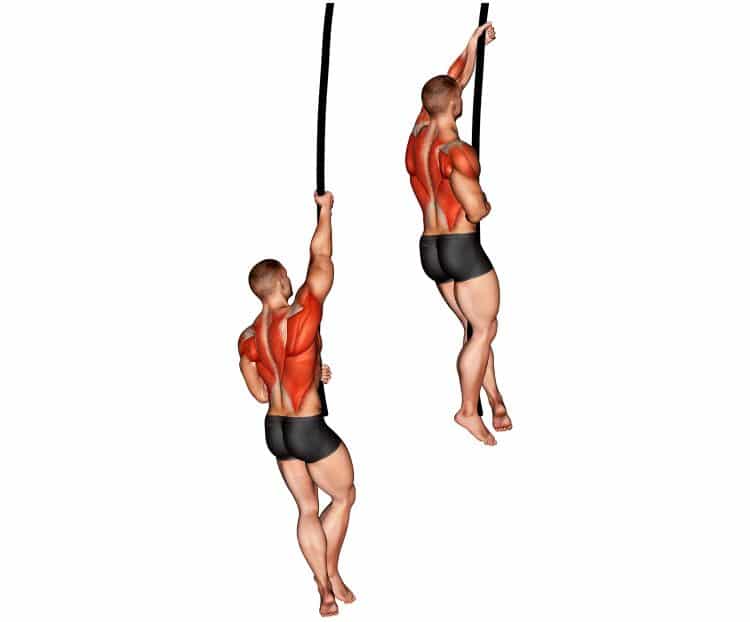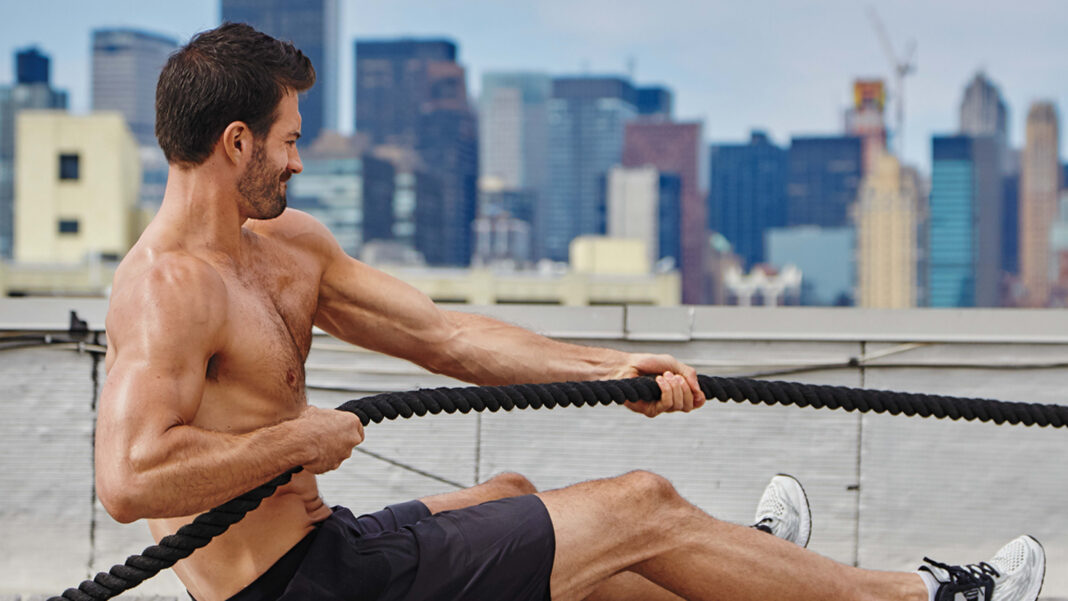Rope Climb (Forearm & Grip Endurance Builder)
The Classic Strength Test That Builds Real-World Grip and Forearm Power
Few movements command respect in the gym like the rope climb. It’s raw, primal, and brutally effective — no machines, no cables, no shortcuts. You’re lifting your entire bodyweight vertically using only your hands, forearms, and sheer determination.
For bodybuilders, strength athletes, and anyone serious about functional muscle, the rope climb is a forearm and grip endurance masterclass.
It builds dense, rope-like forearm muscle, strengthens every tendon from your fingers to your shoulders, and develops a kind of strength that feels athletic, explosive, and real.
Whether you’re chasing hypertrophy, athletic performance, or simply the satisfaction of dominating a movement few can perform, the rope climb deserves a spot in your arsenal.
This explainer will break down the mechanics, muscle focus, progressions, and programming strategies you need to master it — whether you’re scaling a climbing rope in a gym, a tree in your backyard, or a functional fitness rig.
Muscles Worked
Primary Muscles:
- Forearm Flexors – grip the rope and resist slipping.
- Brachioradialis – key stabilizer during pulling and holding phases.
- Finger Flexors (Flexor Digitorum Profundus & Superficialis) – clamp down on the rope.
- Biceps Brachii & Brachialis – provide vertical pull strength.
Secondary Muscles:
- Latissimus Dorsi – primary mover for climbing motion.
- Rear Deltoids & Rhomboids – assist in shoulder retraction.
- Core & Hip Flexors – stabilize body position during ascent.
💡 Though it’s a full-body movement, rope climbs torch your forearms and grip like nothing else. You’ll feel it deep in the forearm flexors after just a few climbs.
Benefits of Rope Climbing for Forearms
✅ Unmatched Grip Endurance: Holding your entire bodyweight forces forearm flexors to contract for extended periods, building endurance and vascular density.
✅ Functional Strength Development: Strength gained here directly transfers to pull-ups, deadlifts, and all grip-dependent lifts.
✅ Forearm Hypertrophy: Constant tension promotes growth in both size and density of the forearm muscles.
✅ Tendon and Joint Conditioning: Builds resilience through natural, dynamic movement patterns.
✅ Athleticism & Coordination: Improves body control, coordination, and movement efficiency.
How to Perform the Rope Climb (Step-by-Step)
- Setup
- Use a 1.5–2-inch thick rope securely anchored from the ceiling or rig.
- Stand beneath the rope with both hands gripping it at about chest height.
- Use chalk to enhance grip and prevent slipping.
- The Ascent (Climbing Phase)
Option A: Without Legs (Advanced – Maximum Forearm Challenge)
- Hang fully extended from the rope using only your hands.
- Pull yourself upward explosively with your arms while regripping higher with each pull.
- Keep your body tight — avoid swinging.
- Continue climbing until you reach the top or desired height.
- Descend under control — this eccentric phase builds even more forearm strength.
Option B: With Leg Wrap (Beginner to Intermediate)
- From a hanging position, pull knees up and wrap the rope between your feet (J-hook or S-wrap technique).
- Press down with your legs to offload some of your bodyweight.
- Pull with your arms, stand up using your legs, and regrip higher.
- Repeat the sequence.
- Descend with slow, controlled steps — focus on tension rather than speed.
- The Descent (Eccentric Phase)
Lower yourself slowly and under full control. The eccentric portion — resisting gravity as you lower — is where maximum forearm and tendon adaptation happens.
Never slide down the rope; always control the descent to avoid burns and overuse injuries.
Technique Cues
- Keep wrists neutral and grip firm but not over-squeezed.
- Maintain shoulders packed and core tight.
- Use short, rhythmic pulls rather than jerky movements.
- Avoid excessive elbow flare — keep the motion vertical.
- Focus on active tension in your forearms during every inch of movement.
Programming for Different Goals
- Forearm Endurance & Hypertrophy
- Method: Multiple short climbs for time.
- Prescription: 3–4 climbs of 10–15 feet, resting 60–90 seconds between.
- Progression: Reduce rest or increase climb duration weekly.
- Grip Strength Focus
- Method: Static holds at various heights.
- Prescription: 3–5 sets of 20–30 seconds holds at mid-rope.
- Variation: Alternate single-hand hangs or one-hand partial holds for advanced grip development.
- Power & Athletic Conditioning
- Method: Explosive rope climbs for speed.
- Prescription: 4–6 short bursts (10–12 feet) as fast as possible.
- Focus: Maintain technique while climbing with intensity.
Bodybuilder’s Strategy & Integration
Even though rope climbing isn’t a “pump” exercise, it complements physique training in powerful ways:
💪 1. Use It as a Forearm Finisher
After curls, extensions, or wrist work, perform rope climbs or static hangs to fatigue the deep flexors.
💪 2. Alternate with Weighted Carries
Pair rope climbs with farmer’s carries to train both grip crush and grip endurance.
💪 3. Incorporate Controlled Descents
Slow descents (5–10 seconds) maximize time under tension for the forearms — a secret hypertrophy tool.
💪 4. Combine with Fat Grip Work
If no rope is available, use thick-grip pull-ups or rope attachments on cables as substitutes.
💪 5. Progressive Overload = Height, Speed, or Duration
You can’t just add weight like in curls — progress by climbing higher, climbing faster, or holding longer.
Variations & Alternatives
| Variation | Description | Focus |
| Seated Rope Pull (Weighted Sled) | Sit on floor and pull a rope attached to a sled or plate | Forearm flexor and biceps focus |
| Rope Pull-Up | Hang rope from bar and perform pull-ups using rope grip | Static grip & flexor endurance |
| Towel Pull-Up | Substitute towel for rope | Similar grip and forearm demand |
| Single-Arm Rope Hold | Hold one arm at a time for max time | Extreme unilateral grip challenge |
Common Mistakes & Fixes
| Mistake | Why It’s a Problem | Fix |
| Using too much momentum | Reduces muscle tension | Use controlled pulls and slow descents |
| Ignoring the eccentric phase | Misses major strength gains | Lower slowly under control |
| Over-gripping | Leads to premature fatigue | Maintain firm but relaxed grip |
| Poor rope technique | Can cause burns or slips | Learn proper leg wrap and hand-over-hand form |
| Neglecting both hands equally | Creates asymmetry | Alternate starting sides each climb |
Sample Rope Climb Workouts
- Classic Strength & Endurance Session
- Rope Climb (Leg Wrap) – 4×10–15 ft
- Rope Hang (Midway Hold) – 3×30s
- Reverse Curl – 3×12
- Wrist Roller – 3×1 full roll-up/down
- Advanced Grip Builder
- Rope Climb (No Legs) – 5×10 ft
- Slow Eccentric Descent – 5×8–10 sec per climb
- Towel Hang – 3×Max Hold
- Finger Extension Band Work – 3×20
- Functional Power Day
- Rope Sprint Climb (10 ft, timed) – 6×Fastest Time
- Farmer’s Carry – 3×40m
- Thick Bar Hold – 3×20–30s
- Core Stability Work (Hanging Leg Raises) – 3×12
Safety & Progression Tips
⚠️ Always check rope integrity and anchor points before climbing.
⚠️ Use a crash mat or padded surface underneath.
⚠️ Build up grip strength gradually with towel hangs and pull-ups first.
⚠️ Keep nails trimmed to prevent rope snags or tears.
⚠️ Warm up wrists, elbows, and shoulders before heavy climbing sessions.
Recovery & Maintenance
- Stretch forearms and wrists post-session.
- Contrast baths for hands and elbows improve recovery.
- Self-massage or use a lacrosse ball on the forearms.
- Prioritize forearm extensors in recovery to avoid flexor dominance.
Training Frequency
- Beginners: 1x per week for technique and tendon adaptation.
- Intermediate: 2x per week with one endurance and one power session.
- Advanced: Up to 3x weekly, alternating climb variations and volume.
Practical Takeaways
✅ Rope climbing builds real-world forearm power and grip endurance unmatched by machines.
✅ Excellent crossover benefits to pulling strength, athletic coordination, and tendon resilience.
✅ Control the descent phase — that’s where the real muscle-building magic happens.
✅ Integrate progressively and balance with recovery to prevent elbow overuse.
✅ A true test of strength — if you can master the rope climb, your forearms are elite.
Conclusion
The rope climb is more than just a display of strength — it’s a litmus test of grip endurance, body control, and upper-body mastery. It challenges your forearms in a uniquely functional way, forging dense, strong, and enduring muscle that translates to every lift and sport.
For bodybuilders, the rope climb offers the perfect blend of performance and aesthetics — thick forearms, visible vascularity, and tendon strength that supports heavy training for decades.
Add rope climbing into your training, and you’ll not only look stronger — you’ll be stronger, in every sense of the word.





